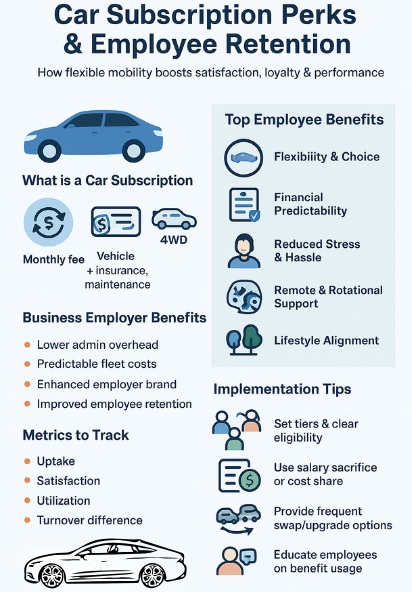In a competitive labour market, employee benefits are no longer just an add-on; they’re essential for attracting, retaining, and motivating talent. As the expectations of what a job “offers” evolve, so too does the demand for benefits that align with modern lifestyles, flexibility, and work-life balance.
One of the benefits rapidly gaining traction is car subscription services. Unlike traditional company cars, leases, or cash allowances, car subscriptions offer flexibility, simplified costs, and greater choice. When deployed well, they can become powerful tools for boosting employee satisfaction and loyalty.
At Trend Rentals, we see car subscription not just as a mobility solution for individuals, but as a strategic employee perk. In this blog, we explore how car subscription services work, why they’re especially appealing to employees, how businesses can implement them, and the impact they can have on retention and engagement.

What Is a Car Subscription Service?
A car subscription service is an all-inclusive vehicle access model where the user pays a recurring fee (weekly, monthly) for the use of a vehicle. The fee typically includes registration, insurance, servicing and maintenance, roadside assistance, and sometimes additional perks like routine upgrades.
Key features of car subscriptions compared with traditional car ownership or leasing:
- Low or zero upfront costs — no large deposit or capital outlay.
- Maintenance, insurance, registration bundled in one payment.
- Flexible duration — month-to-month or short term, with options to swap vehicles.
- Transparent pricing — fewer hidden costs, easier budgeting.
Trend Rentals’ Business Car Subscription Plans emphasise predictable monthly payments, handling maintenance, insurance, and roadside assistance, freeing up employee or employer bandwidth from administrative burdens.

Why Employees Love Car Subscription Perks
When offered as a perk, car subscription services hit several employee needs and desires. Here’s how they help increase satisfaction, loyalty, and engagement.
1. Greater Flexibility & Choice
Employees are no longer satisfied with “one-size-fits-all” benefits. Many want flexibility in how they travel, what kind of vehicle they drive, and when they use it.
- Want an SUV for family road trips but a compact car during the week? Subscriptions can let employees switch.
- For staff on rotational sites, contractors, or remote work, having flexible vehicle access is a major plus.
This flexibility signals trust and empowers employees to choose what best fits their lifestyle.

2. Reduced Financial Stress
Owning a vehicle comes with many unpredictable costs — maintenance, insurance, registration, fuel, unexpected repairs. Subscriptions bundle many of these costs and make them fixed or predictable.
Employees don’t have to worry about big bills popping up, which can reduce stress and allow them to focus on work. This is especially valuable for those just starting out or with tighter budgets.

3. Enhanced Job Satisfaction & Retention
Offering meaningful perks has real impact on satisfaction, which is closely tied to retention. When employees feel valued, when their employer invests in benefits that enhance daily life, loyalty rises.
Data from other fleet/driver-benefit studies shows that employees highly rate benefits that reduce hassles (vehicle availability, maintenance) and improve lifestyle (vehicle choice, comfort). Though not specific to subscription services for all, the parallels are strong.

4. Brand Perception & Attraction
Perks like car subscriptions are visible and tangible. They help an employer stand out in recruitment:
- Great for attracting top talent who value modern working arrangements and benefits.
- Helps improve employer brand and gives a message: “We invest in your mobility and well-being.”

5. Supporting Remote and Rotational Workforces
In industries like mining, construction, and energy, many employees are based in remote or regional areas, often on rotational shifts. Car subscription services align well with these arrangements since:
- Employees may not need permanent vehicles but need reliable transport when on site.
- Subscriptions mean no long-term commitment or idle vehicles.
- The flexibility helps operations scale up or down with project demand.

How Businesses Can Offer Car Subscription Perks Effectively
To deliver real value (for both business and employees), simply signing up to a subscription provider isn’t enough. It needs thoughtful design and management.
Here are best practices and steps to implement:
Step 1: Define the Scope of the Benefit
Decide what level of access you’ll provide. Some options:
- Full subscription allowance: employees choose a vehicle within a defined budget.
- Tiered vehicle models: different roles have access to different vehicle categories.
- Hybrid model: subscription service for some employees, cash car allowance for others.
Be clear about what’s included: fuel, insurance, maintenance, roadside, etc. Use providers like Trend Rentals Business Car Subscription to define those scopes with clarity.
Step 2: Structure the Financials
Decide who pays what — employer, employee (via salary sacrifice), split cost, etc. Consider:
- Fiscal/tax implications
- Fringe Benefits Tax (FBT) in Australia
- Salary sacrifice programs to reduce taxable income while getting perks
Some other providers in Australia are using novated subscriptions or EV-centric subscription plans which allow employees to get tax benefits, though regulations differ.
Step 3: Choose the Right Subscription Provider
Make sure provider meets these criteria:
- Transparent pricing, no hidden fees.
- Variety of vehicles (sedans, SUVs, 4WDs if needed).
- Maintenance, insurance, registration included.
- Flexibility in terms of period and ability to swap vehicles.
Trend Rentals offers various fleet options and site-compliant vehicles, plus flexible terms, which makes it suitable for a wide range of roles.
Step 4: Ensure Clear Policies & Communication
- Define usage rules: personal vs business use, kilometre limits, permitted drivers.
- Clarify responsibilities: what happens with damage, maintenance, or accidents.
- Provide a clear process for upgrades, swaps, or cancellations.
- Offer education or introductions when enrolling employees: explain the costs, benefits, expectations.
Step 5: Monitor & Review
- Track usage, satisfaction, and cost.
- Get feedback from employees: does the benefit work for them?
- Adjust vehicle categories, budget caps, or eligibility based on feedback.
Impacts on Retention, Satisfaction & Business Performance
Putting car subscriptions in place as employee perks doesn’t just feel good — there are measurable returns.
Retention & Loyalty
When employees feel their employer cares about their daily practical concerns (like commuting, personal mobility), they are less likely to leave. The cost of turnover is high — recruiting, onboarding, and training new staff can far exceed the expense of providing a vehicle benefit.

Productivity and Well-Being
Reliable transport means fewer delays, less stress, and more time for rest or planning. Employees arriving on time, less worried about breakdowns or unexpected maintenance, are more productive. Plus, job satisfaction has personal well-being spillovers: reduced anxiety about car costs, more flexible lifestyle.
Studies in related sectors show employees with good vehicle benefits report higher job satisfaction, especially when the benefits include flexibility and minimal personal hassle.

Cost Efficiency and Predictability
For employers, subscriptions can offer more predictable budgeting. Rather than maintaining a fleet (with capital costs, depreciation, storage, repairs), you pay for use. If you use a trusted provider (like Trend Rentals’ business subscription service), much of the maintenance, insurance, and other costs are wrapped in.
Also, risk is reduced: vehicle depreciation, unexpected repair costs, or compliance failures are managed by provider rather than employer directly.

Employer Brand and Attractiveness
In talent-rich job markets, benefits like flexible vehicle access become differentiators. Job seekers often compare total benefits packages; visible perks enhance employer reputation. If your employees use modern, well-maintained vehicles, that reflects positively on your organisation’s image.

Potential Challenges & How to Overcome Them
No benefit is perfect out-of-the-box. There are risks and challenges to think through.
1. Tax and Regulatory Considerations
In Australia, Fringe Benefits Tax (FBT) and other regulations might apply. Salary sacrifice and novated subscription models can help, but you’ll need to ensure compliance and sound financial planning.

2. Cost Control
Without controls, vehicle perks can lead to outsized costs: high-kilometre use, frequent upgrades, damage, or misuse. Mitigate by:
- Setting predefined vehicle categories or caps
- Clear usage policies
- Tracking usage and costs via telematics or oversight

3. Vehicle Supply and Peak Demand
Vehicle availability may tighten during certain periods (e.g., seasonal demand, supply chain delays). To manage:
- Have flexible terms or backup providers
- Plan offerings ahead of peak periods
- Use providers with larger fleets and variety (Trend Rentals’ fleet options are broad)

4. Equity and Fairness
Ensure the benefit is perceived as fair; avoid favouring senior roles only, unless clearly justified. Consider making tiers accessible across the organisation so more staff benefit.

5. Risk Management
Car usage has inherent risks: accidents, liability, insurance claims. Ensure:
- Vehicles are adequately insured
- Employees are aware of duties and responsibilities
- Maintenance is up to standards
- Usage policies are clear

Implementation Example: Trend Rentals + Employee Perks Model
Here’s a hypothetical implementation (or adapted real) scenario using Trend Rentals as the subscription provider.
| Element | Detail |
|---|---|
| Eligibility | Full-time employees (12+ months), contractors with regular hours, rotational site staff |
| Vehicle Tiers | Tier 1: compact & city sedans Tier 2: SUVs / 4WDs (for regional or family use) Tier 3: mine-site compliant or heavy-duty utes for field roles |
| Cost Sharing | Employer covers base subscription; employee covers personal use excess or fuel if above threshold; possibility of salary sacrifice arrangement |
| Term & Flexibility | Minimum subscription period (3 or 6 months), with option to swap or upgrade quarterly; cancellation notice (e.g., 30 days) |
| Support & Add-ons | Maintenance, insurance, roadside included; extras like roof racks, child seats, site spec modifications as needed via Trend Rentals fleet options |
If done properly, this model can deliver lower total cost of ownership (from employer side), high satisfaction, better employee morale, reduced turnover, improved recruitment.
Real-World Comparisons & Related Models
To help you see the broader landscape:
- Some businesses use novated leases / novated subscriptions, where employee and employer share vehicle costs via payroll, and tax advantages may apply.
- Flexible EV subscription and salary packaged EV plans are emerging, which add environmental benefits and possible tax benefits.
- Providers in car subscription space are increasingly including business-oriented features: site-compliant vehicle builds, fleet tracking, flexible swap policies, etc. Trend Rentals is one of them.
Measuring Effectiveness: Metrics to Monitor
To ensure the employee car subscription perk is doing its job, organisations should be tracking:
- Uptake rate: How many employees are enrolling?
- Employee satisfaction / feedback surveys specific to mobility benefit
- Retention / turnover rates among those with the perk vs without
- Costs: Actual subscription costs, usage, fuel, damage, extras vs budgeted amounts
- Vehicle utilisation: How often vehicles are used, kilometres driven, idle periods
- Carbon footprint or emissions if using low-emission / EV options
These metrics provide insights into what’s working, what needs adjustment, and whether the investment is paying off.
Conclusion: Why It’s Worth It
Car subscription services offer a modern, flexible, and employee-centric alternative to traditional company car perks or vehicle allowances. For businesses, the advantages are clear: cost predictability, less administrative burden, flexible fleet management, and a perk that actually matters.
For employees, it signals that the employer is modern, caring, and responsive to their needs — not just offering lip service, but delivering real value: freedom, less stress, and mobility without complexity.
If you’re considering introducing a mobility perk, a car subscription service via a trusted provider like Trend Rentals Business Car Subscription might be your best launching point. Define clear policies, choose good vehicle options, monitor regularly, and you’ll likely see benefits in retention, satisfaction, and productivity.